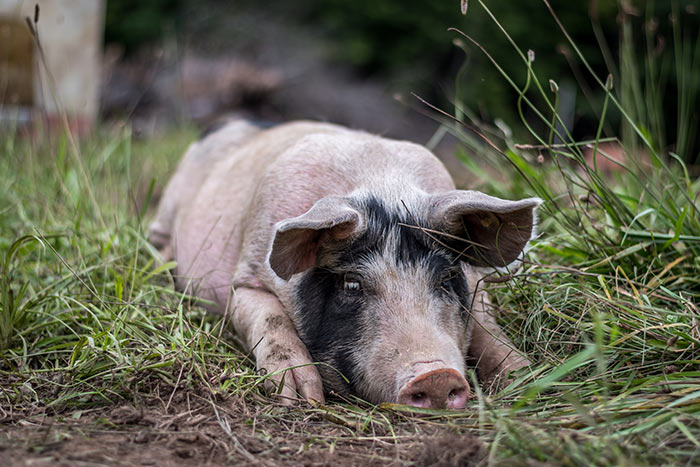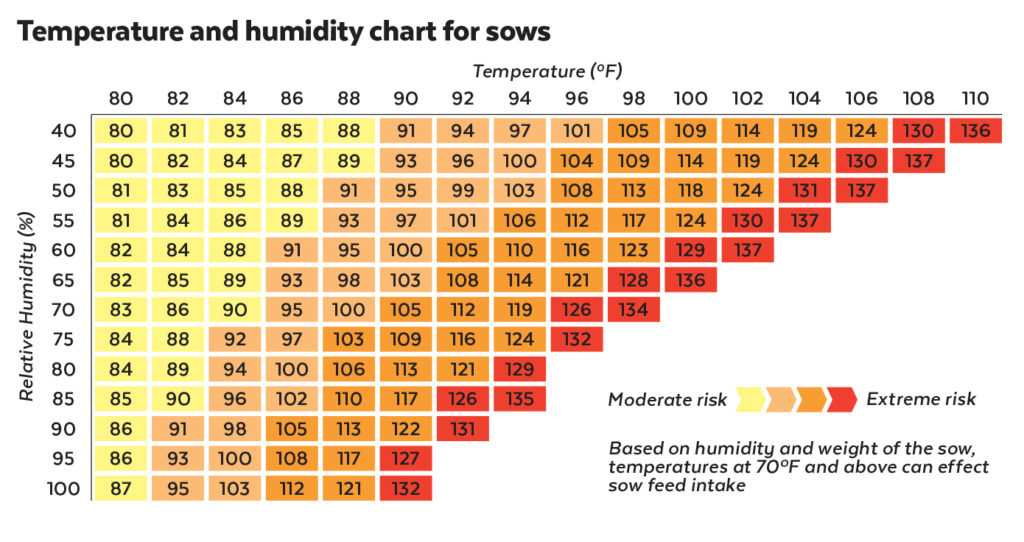One of the key attractions of our Certified Regenerative by AGW program is its practical…

Avoiding Heat Stress in Pigs
Despite the well-known saying, pigs don’t actually sweat (aside from their snouts) and can struggle to maintain their body temperature. As a result, overheating in outdoor pigs is a key health and welfare concern, and can affect growth rates, fertility and, in severe cases, can lead to death. First, we need to get our terms clear. Sunburn and heat stress are two different conditions. Sunburn is caused by prolonged exposure to ultraviolet light from the sun, while heat stress is caused by the inability of the pig to cool down in hot/humid weather. Pastured pigs can suffer from both, with light-skinned pigs more likely to suffer from sunburn and dark-skinned pigs potentially more susceptible to heat stroke as their dark skin absorbs more heat.
Heat stress in pigs can start at much lower temperatures than you might think and is much more likely at lower temperatures when air humidity is also high. An additional factor is the temperature range your pigs are used to. Research suggests that pigs adapted to colder conditions can succumb to heat stress after relatively low temperature increases. According to one study, pastured sows started reacting adversely when temperatures reached 680F, while indoor sows did not react until temperatures reached 72–770F. Heat stress index charts like the example for sows (see right) are a useful decision tool for management strategies to minimize heat stress risks.
What are the signs of heat stress?
A pig regulates its temperature through panting and through cooling its skin. Panting increases airflow and evaporation of water from the lungs, which releases heat. Pigs will also lie on cool surfaces or in cooler shaded areas to help dissipate heat from their bodies, or cover themselves in water or mud, which helps with evaporative cooling. (Mud also provides some protection against sunburn.)
If your pigs are lying in the shade, panting, they may be beginning to suffer from heat stress. Going off feed is another classic sign: Pigs will markedly reduce their feed intake when too hot, because the digestive process itself releases heat, meaning more heat for the pig to dissipate. Prolonged heat stress—even if relatively mild—can therefore affect growth rates of market hogs, as well as the milk production of lactating sows. Recent research also shows that exposure to heat stress—even for only a few hours—can compromise immune defense systems, exposing the pig to secondary infections.
Heat stress can also lead to fertility loss. Boar sperm volume and quality will both decrease if the boar overheats (an issue you may only identify after the sows you expected to be in pig all return to estrus), while heat stress in sows can lead
to embryo death and reduced litter size. If you experience seasonal fluctuations in returns to service and/or poor litter size, heat stress could be a factor.
How can I prevent heat stress?
The most important action you can take is ensuring pigs have access to wallows where they can get a good coating of mud on their skins. If you don’t provide a place for pigs to wallow you may find they move or break water troughs to create their own mud hole. It is far better to keep drinking water clean and wallowing water muddy, so providing two distinct areas will ensure your pigs are happier and healthier.
A continuous supply of fresh, clean drinking water is obviously essential to pig health –and becomes even more important in hot weather. Warm drinking water does not have the same cooling effect as cold water, so consider where drinking water points are sited and how water is stored to ensure the supply is as cool as possible. Can you put drinkers in the shade or bury plastic water pipes so the water is not heated by the sun?
Ideally, you should provide pigs with shade as well as wallows. Shade can be natural, such as trees and vegetation, or man-made structures, such as windbreak sheets attached to poles
Pig huts may cast some shade but can become unbearably hot unless they are insulated and/or open to allow air flow. While pigs still need comfortable places to lie down, you can safely reduce bedding quantity in hot weather.
Sows will leave their litters to seek relief if farrowing huts are too hot. If piglets are big enough to follow her you can provide shade on the range; however, if you need the sow to remain in the hut with a young litter then ensure vents are open to allow air flow. If high summer temperatures are a regular occurrence, insulated huts that prevent the interior heating up are a worthwhile investment. Alternatively, heat reflective paint on huts or arks can help to reduce heat buildup inside.
Finally, avoid feeding pigs in the hottest part of the day. Feeding either first thing in the morning—or once in the early morning and again in the evening—will ensure the pigs get the nutrition they need.
Will all pigs be affected?
Larger pigs will be more affected by heat stress than smaller pigs, as seen by the optimum temperatures for different ages and sizes of pigs. For example, the optimum ambient temperature for newborn piglets is around 950F; at three weeks old it is 800F; by the time pigs reach above 75lbs in weight the ideal temperature drops to 600F. If a pig gets too far above its optimum temperature range it will suffer from heat stress.
The color of pigs can also affect their propensity for heat stress or sunburn. Although there is some concern that darker colored pigs might absorb more heat, in general smaller breeds with dark skin and long snouts are less susceptible, because they have a greater surface area per pound of body weight
(meaning greater heat transfer), more pharynx area to allow cooling through panting, and natural pigment for protection against sunburn. Interestingly, recent research suggests new genetic lines produce nearly 20 percent more heat than their counterparts bred in the early 1980s, and so could be more susceptible to heat stress.
Heat stress is important
Heat stress can have a significant effect on pig health and welfare, as well as the profitability
of your pig enterprise. Getting prepared for the summer and making sure your pigs can wallow and lie in shade will make things better for them—and for your bottom line.
Writer, Anna Heaton is AGW’s Lead Technical Advisor



